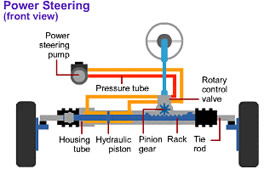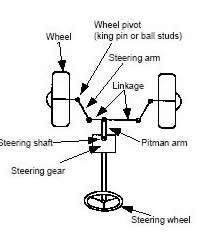Difference between Power Steering and Normal Steering
Key Difference: Power steering is a system that helps in steering the wheels by using some auxiliary network of power. Normal steering is a steering system in which manual force is used for steering. Normal steering is also known as manual steering or non-power steering.
You want to buy a new car and still thinking about the steering system or you are thinking of converting your steering system, then you must have explored both the systems. However, those who do not know much about the steering systems, this article will clear your doubts or provide you the information regarding the power steering and normal steering.
Power steering is a system that helps in steering the wheels by using some source of power. Steering refers to guiding the wheels towards the intended direction. You must be familiar with the steering systems of cars. The driver uses the steering to control the course taken by wheels. Normal steering is totally different type of steering in which manual force is used for steering. However, today most of the cars have power steering systems. Some people may get confuse between electric and electronic power steering. However, they both refer to the same system. The electric power steering is also known as electronic power steering as it uses the electronic steering control unit.
 When we talk about power steering, than we are either referring to hydraulic power steering or electric power steering. Thus, we can say that electric power steering is a type of power steering and thus has all the features of a power steering. There are two basic steering mechanisms:-
When we talk about power steering, than we are either referring to hydraulic power steering or electric power steering. Thus, we can say that electric power steering is a type of power steering and thus has all the features of a power steering. There are two basic steering mechanisms:-
1. Rack and pinion steering- in this system a pinion gear is attached to the steering shaft which means that as the steering wheel is turned it turns the pinion gear(circular) and then moves the rack (linear). It is basically using the rotational motion of steering wheels and then converting this rotational motion into the linear motion. This linear motion is required to turn the wheels.
2. Recalculating ball steering- in this system, a box is fastened over a worm drive that contains many ball bearings. These ball bearings loop around the worm drive and these balls moves out into a recirculation channel and again gets back into the worm drive. When the steering wheel is turned, the worm drive turns and forces the balls to press against the channel inside the nut. Now this forces the nut to move along the worm drive
Let us now understand the basic concepts of power steering. Power steering uses hydraulics or fluid pressure in order to help the steering systems. Power steering is preferred when quick turns need to be taken.
There are three main power steering components- power steering pump, power steering fluid reservoir, steering gear box. Power steering can be of three types:-
- Hydraulic power steering
- Electric power hydraulic steering (EPHS)
- fully electric power steering (EPS)
Hydraulic power sheerings mainly use hydraulic fluid and the pressure that is generated through this hydraulic fluid helps the driver in steering the wheels. In EPHS the customary drive belts and pulleys that drive a power steering pump are replaced by a brushless motor. It is driven by an electric motor and thus also reduces the amount of power that needs to be taken from the engine otherwise. The third category is electric power steering. In this kind of system, an electric motor replaces the hydraulic pump and a fully electric power steering system is established. The electric motor is either attached to the steering rack or to the steering column. The very important component is the electronic control unit that controls the steering dynamics.
Most of the steering systems that are used today are of power steering type. Very few systems use manual steering. EPS are often preferred for the fuel economy and lower emission.
emission.
On the other hand, normal steering requires more efforts to steer the vehicles. The only energy source for the manual steering system is the force that the driver applies to her steering wheel. However, power steering always allows normal steering to be available; this may help in case of the problem in engine or in the case of power assist system failure.
There are several types of manual steering systems like
- Worm and sector
- Worm and Roller
- Cam and lever
- Worm and nut
- rack and pinion
Some of the differences are listed in the table below:-
|
|
Power Steering |
Normal Steering |
|
Definition |
Power steering is a system that helps in steering the wheels using some source of power. |
Normal steering is a system in which manual force is used for steering. |
|
Mechanism |
Hydraulic : rack and pinion, re-circulating ball and nut, worm and roller, hydrostatic Electrical: Rack and pinion, column driven EPS, pinion driven EPS, Rack driven EPS |
Normal steering rack uses a rack and pinion, worm and roller and recirculation ball and nut. |
|
Response |
Comparatively quick |
Comparatively slow |
|
Resistance to wheel movement |
Less |
More |
|
Preferred |
Comparatively heavy weight vehicles |
Low weight vehicles |
|
Elements |
A hydraulic pump, fluid reservoir, hoses, lines; and either a power assist unit mounted on, or integral with, a power steering gear assembly |
Steering wheel and column, a manual gearbox and pitman arm or a rack and pinion assembly, linkages; steering knuckles and ball joints, and 4. the wheel spindle assemblies |
|
Advantages |
Absorbs road shocks, minimum efforts, greater safety and controllability under critical situations |
Mechanical connection between the steering wheel and the wheel and all the components continues to be maintained without the help of the auxiliary power |
Image Courtesy: cartalk.com, valvehydraulic.info









Add new comment